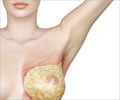
Microwave imaging relies upon the known differences in the so-called dielectric properties of cancerous tissue and normal tissue--that is, their ability to conduct electricity or sustain an electric field. In the technique, the breast is suspended in a liquid bath (but not compressed) and closely surrounded by an array of 16 antennae. Each antenna illuminates the breast individually with a very low power microwave signal, with approximately one one-thousandth the power of a cell phone, while the other 15 antennae receive the signals transmitted through the breast; this is repeated for all 16 antennae, providing data that can be used to produce a 3-D representation of the breast, including the location of both normal and cancerous tissue.
"The iterative image reconstruction algorithm computes what the dielectric property distribution must have been to generate the measured signal patterns," Epstein said. "It is quite similar to X-ray computed tomography, where the target is radiated from all of the surrounding directions and the data is synthesized to create an image of the internal structures."
Source-Medindia















